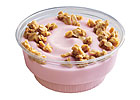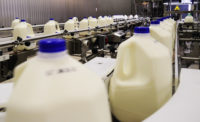
Cultures for cheese are very specific to cheese variety. Sometimes even the slightest variation in strain can make a noticeable flavor difference.
Source: Wisconsin Milk Marketing Board
Source: Wisconsin Milk Marketing Board
Milk can be efficiently processed into a variety of dairy foods with a little help from acid-producing bacteria and/or food-grade acidulants. Indeed, milk, an almost neutral fluid with a pH in the range of 6.4 to 6.8, can become hard cheese when it drops about one pH point; a soft, fresh cheese when it drops another; and yogurt when it drops a bit more.
Milk is an ideal substrate for the growth of microorganisms. Some are inherently present in milk, while others are selectively added for their specific functionalities, many of which rely on the process referred to as fermentation.
What happens to milk during fermentation? Bacterial cultures are added to pasteurized milk, which is incubated at 104° to 111°F for several hours. During this time, the bacterial population grows and produces acid from lactose, reducing the pH of milk. This destabilizes the micellar casein, coagulating milk.
The activity of lactic acid bacteria has one immediate result. It improves lactose digestion in lactose intolerant individuals who cannot digest lactose due to lack of the enzyme (lactase) that performs this function. Fermentation reduces lactose levels by 20% to 30% (from about 4.5% in raw milk).

Though yogurt can be made with two basic cultures, most formulations contain additional cultures that provide healthful benefits. These are referred to as probiotics.
Source: Wendy’s
Source: Wendy’s
Cheese cultures
Bacterial cultures are important in the manufacture of most cheeses. They serve two functions. First, they cause milk to become more acidic, thus aiding its coagulation. Second, the cultures help develop the flavor of the cheese. Milk can also be acidified by adding food-grade acidulants, which is the process often used in the manufacture of fresh cheese.Cheesemaking cultures that produce acid are typically referred to as starters; whereas non-acid-producing cultures-cultures added for the purpose of flavor or texture development-are referred to adjuncts.
Specific cultures are used to make specific cheeses . . . and sometimes, atypical cultures for a certain cheese become helpful when modifying the cheese’s composition. For example,Lactococcus cremorisis the preferred bacterium for Cheddar cheese. More recently,Lactococcus cremorishas been recommended for low-fat and fat-free Cheddar-cheese production. However, cheese made with slow acid-producing cultures such asLactococcus cremoristends to ripen slower. To overcome this, adjunct cultures such asLactobacillus helveticusandLactobacillus caseican increase flavor and aroma sooner.Brevibacterium linens, typically used for brick and Limburger cheeses, may also be used as an adjunct to speed flavor development in reduced-fat and full-fat Cheddar cheeses.

Cultures are microorganisms used to acidify milk in the production of an array of dairy products, including yogurt, butter and cheese. They facilitate the fermentation process that provides the taste and texture to these foods, as well as other foods including sausages, pickles and beer.
Source: Rockbottom Brewery
Source: Rockbottom Brewery
Cultured dairy foods
In the manufacture of yogurt, a symbiotic blend ofStreptococcus thermophilusandLactobacillus bulgaricusis typically used. Although they can grow independently, the rate of acid production is much higher when used together than either of the two organisms grown individually.Streptococcus thermophilusgrows faster and produces both acid and carbon dioxide. The formate and carbon dioxide produced stimulatesLactobacillus bulgaricusgrowth. On the other hand, the proteolytic activity ofLactobacillus bulgaricusproduces stimulatory peptides and amino acids for use byStreptococcus thermophilus.These microorganisms are ultimately responsible for the formation of typical yogurt flavor and texture. Flavors come from the fermentation products of lactic acid, acetaldehyde, acetic acid and diacetyl. The yogurt mixture coagulates during fermentation due to the drop in pH. TheStreptococcus thermophilusare responsible for the initial pH drop of the yogurt mix to approximately 5.0. TheLactococcus bulgaricusare responsible for a further decrease to pH 4.0.
Acidified dairy beverages, which can take the name of yogurt drink, cultured milk, smoothie, etc., typically start out by following a yogurt manufacturing process. After pH 4.0 is reached, the mixture is cooled and other ingredients are added, such as color, fruit, fruit juice, flavors, sweetener and stabilizer. The mixture is agitated and often the pH is adjusted with lactic acid in order to have a final pH of 3.8 to 4.2. Further processing depends on the particular formula and packaging requirements.
Acidophilus milk is a traditional milk fermented withLactobacillus acidophilus, which is believed to have therapeutic benefits in the gastrointestinal tract. Some acidophilus milk has an acidity as high as 1% lactic acid, but for therapeutic purposes 0.6-0.7% is more common.
Kefir is a fermented, effervescent milk drink similar in taste and texture to drinkable yogurt and made from a unique blend of cultures, some produce acid while others contribute solely to texture or health benefits. These include potential benefits such as enhancing the immune system, stimulating digestion, easing lactose intolerance, lowering cholesterol, protecting against cancer and controlling the growth of harmful yeast overgrowth.
To achieve this, some kefir is made with 10 cultures, together referred to as “kefir cultures.” These includeLactobacillus lactis,Lactobacillus rhamnosus,Streptococcus diacetylactis,Lactobacillus plantarum,Lactobacillus casei,Saccharomyces florentinus,Leuconostoc cremoris,Bifidobacterium longum,Bifidobacterium breveandLactobacillus acidophilus.
Buttermilk is an interesting product. Originally the fermented byproduct of butter manufacture, today buttermilk is more often made by culturing milk. The culture most frequently used isStreptococcus lactis; however, other cultures includingStreptococcus cremoris,Leuconostoc citrovorum,Leuconostoc cremorisandLeuconostoc dextranicumcan be used individually or in combination to obtain the desired flavor. The final pH of cultured buttermilk is usually 4.6.
Cultures also assist with developing texture in viscosity in products such as buttermilk and sour cream. When dealing with lower-fat versions, selecting strains that provide these functionalities becomes very important.
The milk to make some dairy products, including sour cream, can be acidified by either cultures or direct acid addition. According to 21CFR131.160 sour cream results from the souring of milk by lactic acid-producing bacteria. According to 21CFR131.162 states that acidified sour cream results from the souring of pasteurized cream with safe and suitable acidifiers, with or without addition of lactic acid-producing bacteria. The product must be labeled “acidified sour cream” if this process is used. Acidified sour cream has the same wholesomeness as sour cream; the only difference is in the manufacturing process.
One supplier recently rolled out a direct-set, freeze-dried culture for sour cream that the company says decreases fermentation time, delivers good flavor and texture profiles and provides easy use and storage. One of the main advantages of the culture is its exceptional speed, setting fermentation vats in 11 to 12 hours, while producing a balanced flavor and texture profile in the finished product. Because it is freeze dried, the culture does not require dry ice when being shipped. It can be transported using standard refrigeration or frozen storage.
They all start with milk. Acid makes the milk much more.

